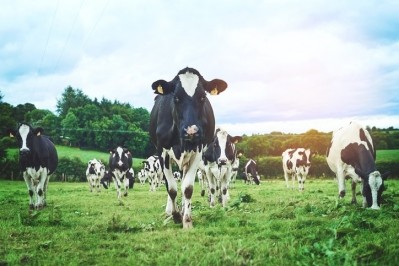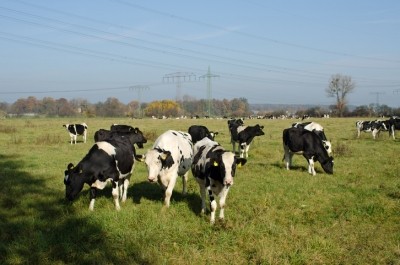Uncertainties continue in methane emission calculations

A team from Pennsylvania State University explored the use of a gridded, bottom-up method to determine methane emissions generated by animal agriculture. The group published its work in the journal of Environmental Science and Technology.
“Therefore, the objectives of the current analysis were, using a bottom-up approach, to (1) estimate livestock (cattle, swine, and poultry) methane emissions in the contiguous US, (2) develop a spatially explicit methane emissions inventory for the livestock sector, and (3) compare this bottom-up analysis with other existing gridded inventories,” said the researchers.
The study was an effort to address a discrepancy previously highlighted in a method that used a top-down measuring approach, said Alexander Hristov, corresponding author and professor of dairy nutrition with Pennsylvania State University.
A top-down measure looks at information gathered by satellites and mathematical modeling.
“Those studies suggested that the livestock emissions were underestimated by up to 90% – that livestock emissions were twice as much as EPA [Environmental Protection Agency] estimated and this triggered my interest,” he told FeedNavigator.
The research group conducted a bottom-up assessment of methane emissions from animals and manure, he said.
“This study just locates emissions on a smaller grid for whoever is interested in using it the top-down methods,” added Hristov. “They have to start with something in their modeling work. They usually use the bottom-up in their modeling work so we are giving them another tool.”
The research suggested that the overall numbers for methane emissions determined by the EPA were mostly accurate, he said. However, they found differences in where some of the emissions sources were located for enteric methane.
Methane production
Agriculture is a source of non-CO2 greenhouse gases, including methane and nitrous oxide, the researchers said. Livestock emissions account for a predicted 48% of those emissions.
Methane emissions stem from methanogenesis in the forestomach of ruminants and the fermentation processes involving manure generated by all production animals, they said. However, there is great uncertainty in the amounts of enteric and manure-based methane generated.
Dry matter intake and feed intake have been shown to play a role in the production enteric methane, they said.
Analyses of past work and data suggest that a bottom-up enteric methane inventory could be established by using a simple calculation model.
Manure-based emissions are more challenging to estimate because multiple variables are involved, the researchers said. Bottom-up calculations often lack some of the needed information to make accurate predictions.
The uncertainty in methane emissions estimated using a bottom-up system add uncertainty to top-down models, which highlights the need for more precise input information, they said. A recent gridded version of the EPA’s methane inventory was used to determine that total US estimates were relatively consistent with the Emission Database for Global Atmospheric Research (EDGAR) but that there were errors in spatial allocation.
Estimating emissions
To calculate emissions in a bottom-up system, the research group established a grid that could be used to locate sources, said Hristov.
“We used a grid pattern because that’s important to use today to have it broken down on as small a grid as possible, and eventually locate the specific sources,” he said. “But that’s still not on the horizon and it needs a lot more work.”
The system involved a spatially explicit and simplified bottom-up analysis, the researchers said.
It examined animal inventories, feed intake-based emissions factors and feed dry matter intake to estimate county-level enteric methane emissions for dairy and beef cows.
The calculations also considered manure-based methane emissions for cattle, pigs and poultry, they said.
The group used available information, feed dry matter intake and a series of coefficients developed by the team and other researchers to calculate methane emissions from cows, said Hristov.
“Using only feed dry intake you can reliably predict enteric methane emissions,” he added.
The picture from manure-based emissions is complicated, he said. Dairy cows produce more manure, while on-range cattle have little to no manure-based emissions, but there are far more beef cattle, including feedlot cattle, being produced than dairy cows.
Other production species like swine and poultry do not produce enteric emissions of methane, he said. However, their production was included in the calculations of manure-based emissions.
“We know a lot less and our estimates are a lot less accurate than enteric,” he said. “The storage facility is important, the environment, temperature all these things make a difference – we don’t have really good data for the facilities across the country.”
To make an accurate model, information would be needed on every manure containment facility in a county or state along with details including facility type, how long it is stored and other information, he said.
“Manure management is a complex process,” he added.
Analysis
Overall, the calculation and analysis found that total livestock methane emissions were comparable to the current levels established by the EPA and those from EDGAR, the authors said.
However, the grid-based or spatial distribution of emissions was different than that determined by both EDGAR and the EPA, they said.
“One of the major messages from our study we can take feed dry matter intake and use coefficients developed by us and by others and estimate methane emissions,” said Hristov.
The assessment also found that results generated by complex and simple models provided similar results, he added.
There were not many surprises in the data, he said. However, the group determined that its factors may be more accurate than those used previously.
But the calculations change the results for areas that have larger numbers of dairy cows or ranged cattle and feed yard cattle, he said.
Cattle on grain have a lower emission level than what has been established in previous calculations, like those done by the EPA.
“Feedlot cattle produce less methane than beef cattle on the range or dairy cows – it has to do with type of feed,” he said. “States that have a lot of beef cattle will have lower emission in our database – that’s why we see total emissions are close to EPA’s [assessment] but the spatial result is different.”
The states found to have the highest combined methane emissions from enteric and manure-based sources were Texas and California, the authors said. However, results for Texas dropped by 36% when compared to earlier EDGAR analysis while results for California rose by 100%.
There are several additional research questions that could be asked, said Hristov. However, there are no plans for a follow-up study at this point.
Although some calculations may be redone if results of the upcoming agricultural survey vary greatly with the 2012 results used for the calculations, he added.
Source: Environmental Science and Technology
DOI: 10.1021/acs.est.7b03332
Title: Discrepancies and Uncertainties in Bottom-up Gridded Inventories of Livestock Methane Emissions for the Contiguous United States
Authors: A. Hristov, M. Harper, R. Meinen, R. Day, J. Lopes, T. Ott, A. Venkatesh, C Randles













